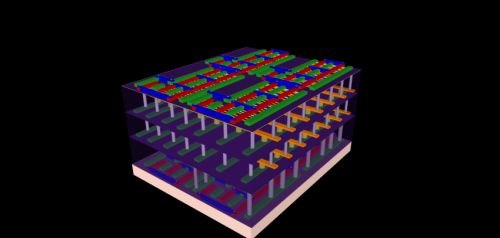This illustration represents the four-layer prototype high-rise chip built by Stanford engineers. The bottom and top layers are logic transistors. Sandwiched between them are two layers of memory. The vertical tubes are nanoscale electronic …more
For decades, the mantra of electronics has been smaller, faster, cheaper. Today, Stanford engineers add a fourth word – taller.
At a conference in San Francisco, a Stanford team will reveal how to build high-rise chips that could leapfrog the performance of the single-story logic and memory chips on today’s circuit cards.
Those circuit cards are like busy cities in which logic chips compute and memory chips store data. But when the computer gets busy, the wires connecting logic and memory can get jammed.
The Stanford approach would end these jams by building layers of logic atop layers of memory to create a tightly interconnected high-rise chip. Many thousands of nanoscale electronic “elevators” would move data between the layers much faster, using less electricity, than the bottle-neck prone wires connecting single-story logic and memory chips today.
The work is led by Subhasish Mitra, a Stanford professor of electrical engineering and computer science, and H.-S. Philip Wong, the Williard R. and Inez Kerr Bell Professor in Stanford’s School of Engineering. They describe their new high-rise chip architecture in a paper being presented at the IEEE International Electron Devices Meeting on Dec. 15-17.
The researchers’ innovation leverages three breakthroughs.
The first is a new technology for creating transistors, those tiny gates that switch electricity on and off to create digital zeroes and ones. The second is a new type of computer memory that lends itself to multi-story fabrication. The third is a technique to build these new logic and memory technologies into high-rise structures in a radically different way than previous efforts to stack chips.
“This research is at an early stage, but our design and fabrication techniques are scalable,” Mitra said. “With further development this architecture could lead to computing performance that is much, much greater than anything available today.”
Wong said the prototype chip unveiled at IEDM shows how to put logic and memory together into three-dimensional structures that can be mass-produced.
“Paradigm shift is an overused concept, but here it is appropriate,” Wong said. “With this new architecture, electronics manufacturers could put the power of a supercomputer in your hand.”
For more detail: Researchers combine logic, memory to build a ‘high-rise’ chip

